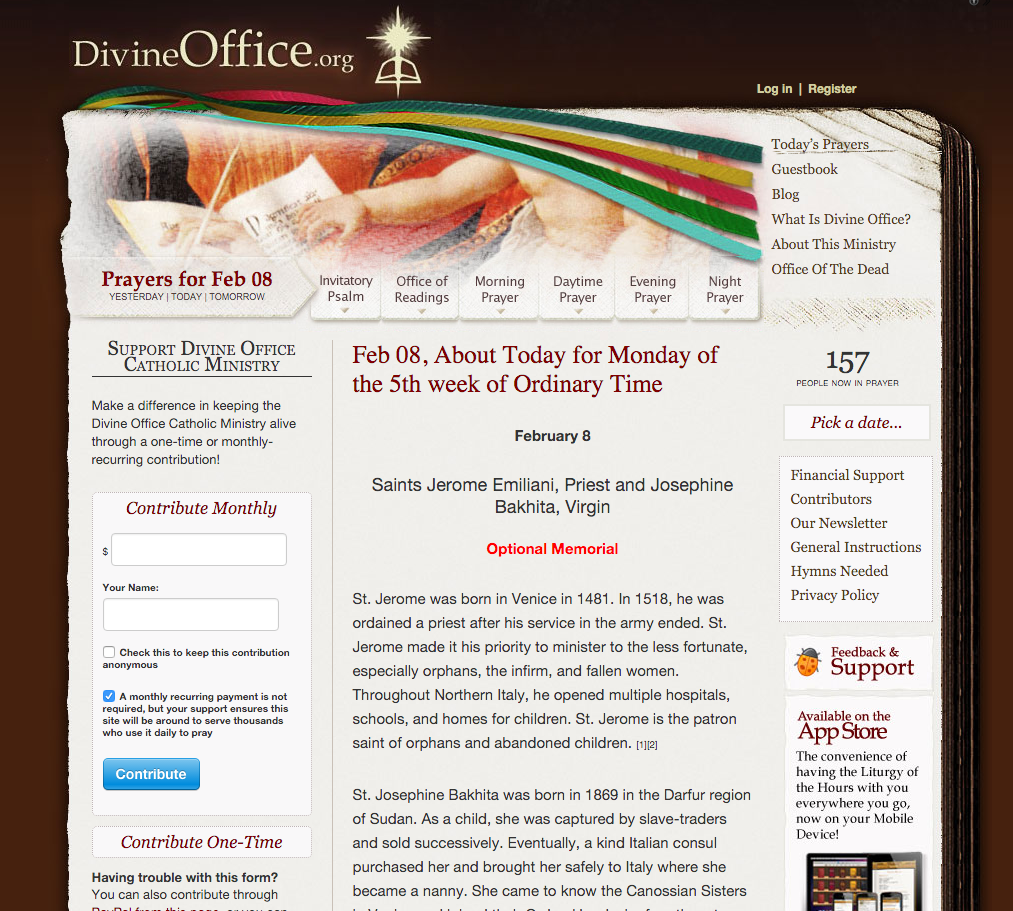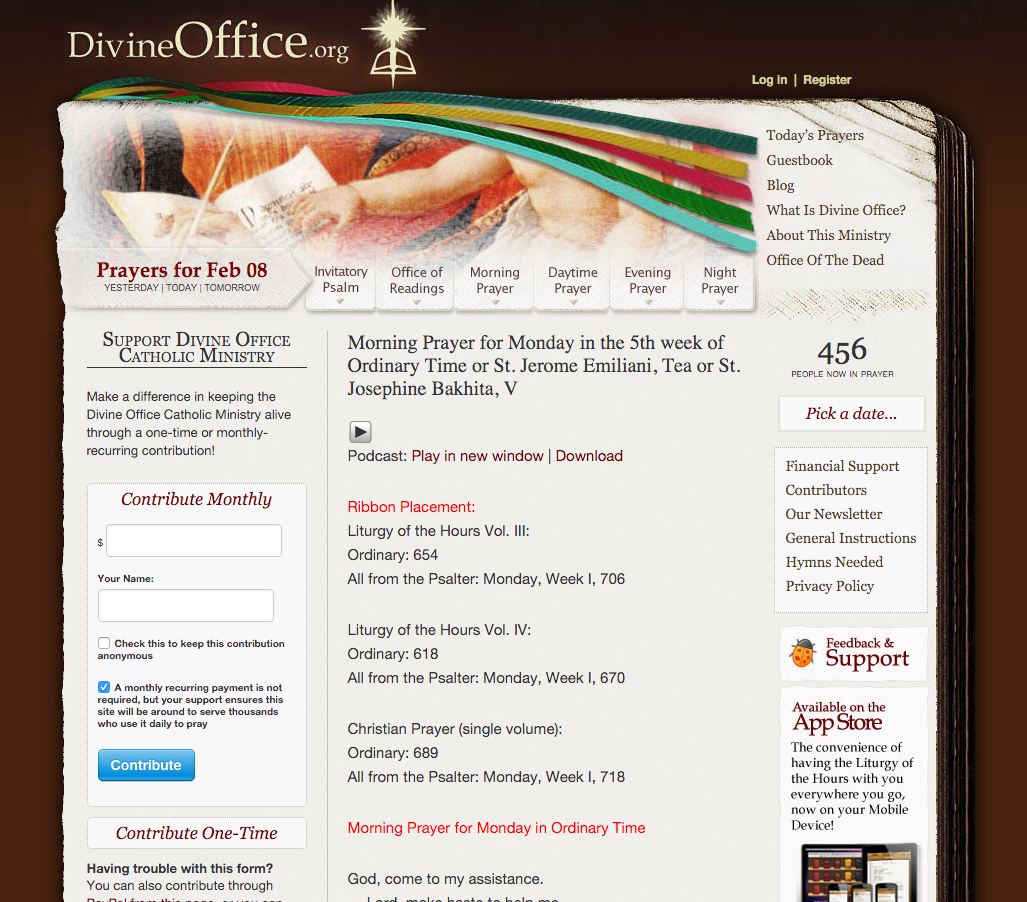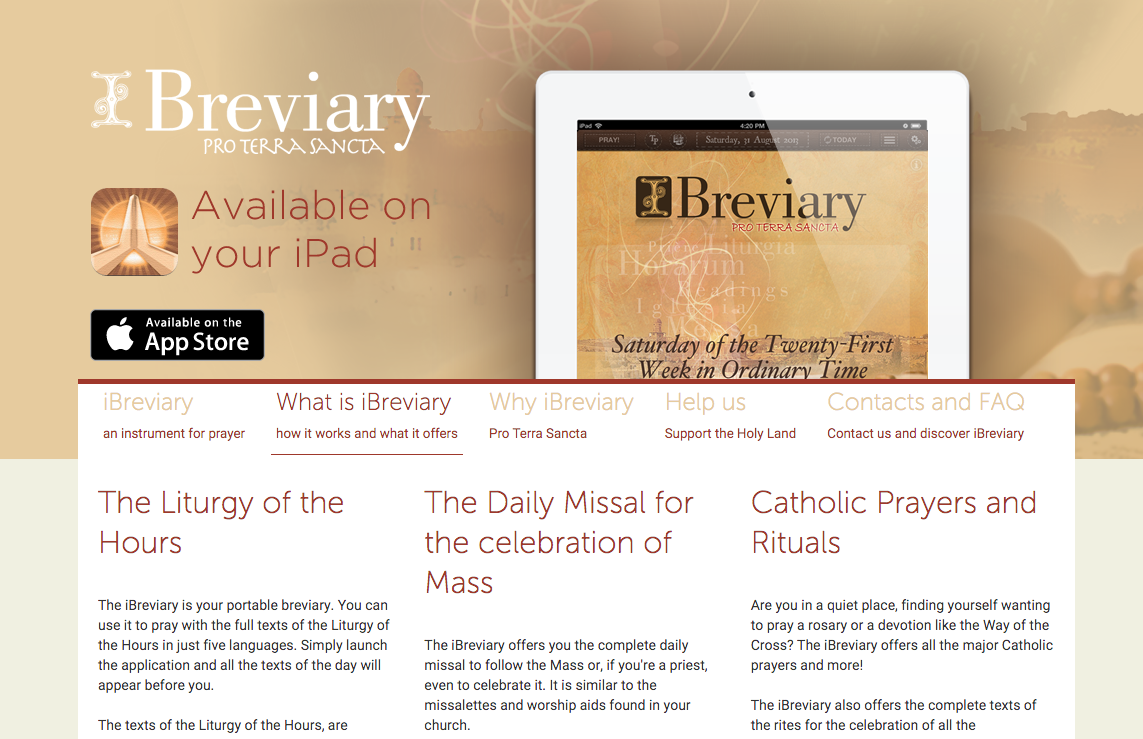[featured-image single_newwindow=”false”]
Still, there are a few “tricks-of-the-trade” that are worth noting before you embark on praying the “public prayer of the Church.” Before we begin let’s “briefly” review what the Divine Office consists of and examine its ancient history.
First of all, the “Divine Office” or “Liturgy of the Hours” is a liturgical prayer of the Church that priests and religious are bound to pray; lay people are encouraged to participate as well. It consists of praying the 150 Psalms of the Old Testament. The practice was adapted from an ancient Jewish custom and had many developments over the centuries. The Jewish people had a tradition of praying three times a day: morning, afternoon and evening.
With the advent of Christianity, Jesus’ apostles at first continued to observe the traditions of the Jews and continued to pray at the appointed times. Over time, however, three times a day did not seem enough, especially after St. Paul exhorted the Thessalonians to “Pray without ceasing.” Christians then went back to the Old Testament for guidance. In particular, they found this passage,
“Seven times a day I praise thee
for thy righteous ordinances.” (Psalm 119:164)
Seven is the biblical number for perfection and Christians saw this as the perfect number of times to pray. One of the earliest documents to have recorded these different hours to pray was the “Apostolic Constitutions” written in the 4th Century (even though it only records six hours and omits the final “Night Prayer” known as Compline, seven hours becomes standard until the 6th Century). In it is written,
Offer up your prayers in the morning, at the third hour, the sixth, the ninth, the evening, and at cock-crowing: in the morning, returning thanks that the Lord has sent you light, that He has brought you past the night, and brought on the day; at the third hour, because at that hour the Lord received the sentence of condemnation from Pilate; at the sixth, because at that hour He was crucified; at the ninth, because all things were in commotion at the crucifixion of the Lord, as trembling at the bold attempt of the impious Jews, and not bearing the injury offered to their Lord; in the evening, giving thanks that He has given you the night to rest from the daily labours; at cock-crowing, because that hour brings the good news of the coming on of the day for the operations proper for the light. (VIII, XXXIV, emphasis added).
St. Benedict of Nursia (who lived in the 6th Century) built upon these seven hours and added an eighth hour, which occurs in the middle of the night. Eight is the biblical number of the “new creation” as Jesus rose from the dead on the eighth day, the day after the Jewish sabbath (which is Saturday). Here is the breakdown:
- Matins (during the night, often at midnight); also called Vigils or Nocturns (Night Office)
- Lauds or “Morning Prayer” (at Dawn, or 3 a.m.)
- Prime or “Early Morning Prayer” (First Hour, around 6 a.m.)
- Terce or “Mid-Morning Prayer” (Third Hour, around 9 a.m.)
- Sext or “Midday Prayer” (Sixth Hour, around noon)
- None or “Mid-Afternoon Prayer” (Ninth Hour, around 3 p.m.)
- Vespers or “Evening Prayer” (around 6 p.m.)
- Compline or “Night Prayer” (before going to bed, typically at 8 p.m. or 9 p.m.)
The Church spread out the 150 Psalms over the course of these hours and eventually created a cycle of prayer. Currently it consists of a 4-Week Psalter where all the Psalms are prayed throughout a period of four weeks (if all of the “hours” of prayer are observed).
Contemplative monasteries keep to this rhythm of prayer, while priests and other active religious tend to “clump” the hours together. For example, if a parish priest is in meetings all afternoon and evening, he will pray Evening Prayer and Night Prayer immediately following each other before retiring for bed. The time of day is less an issue for those in the world than it is for men and women of the cloister.
In any case, if a person wants to get started praying the Divine Office, the easiest way in today’s world is to pray “digitally.”
There are many options, so I will simply highlight two of the most popular: “DivineOffice.org” and “iBreviary.”
DivineOffice.org
This particular apostolate has created a FREE and beautiful website where you can pray the Divine Office in addition to offering some great apps for any mobile device as well as a native app for the Mac. For our purposes I will explain through screenshots how to use their website:

When you visit their website, you are greeted with information about the current day in the 4-Week Psalter. Today is the “Monday of the 5th Week of Ordinary Time” and there are two “Optional Memorials” that can be celebrated: Saints Jerome Emiliani and Josephine Bakhita. Similar to Mass, the Divine Office observes the “Liturgical Calendar” and so when the day falls on a saint’s feast day, the liturgy changes to celebrate it. To briefly explain, there are four “ranks” of feasts:
- Solemnities (i.e. Sundays, & Holy Days of Obligations)
- Feasts (i.e. Saints who are universally celebrated and of major historical significance: Saint Luke the Evangelist, Saint Andrew the Apostle, etc.)
- Memorials (i.e. Saints who are universally celebrated throughout the Church and on the general calendar for the entire Church: Saint Therese of Lisieux, Saint Teresa of Avila, etc.)
- Optional Memorials (i.e. Saints who are locally celebrated and are not necessarily found on all calendars; these feast days are “optional” and do not supersede the liturgy of the day)
For starters, I suggest praying Morning Prayer, Evening Prayer and Night Prayer. Those are the “principal” hours of the day and are the most important. If you can’t seem to find the time to pray all three, choose one and be faithful to it.
After you click on “Morning Prayer,” you will see this screen:

One benefit of this site is that it provides the “Ribbon Placement” if you have a physical breviary. I will explain what this means in the next article in this series. At the top of the screen there is a “play” button where you can listen to the Divine Office being prayed and pray along if you wish.
As a note, it is proper to pray the “Invitatory Psalm“ before praying the first hour of the day. I will explain this further in the next article. For our purposes today, I will highlight “Morning Prayer” as a template so that you understand how to pray all of the other hours.
As you scroll down, you will notice a basic outline. Along with this outline there are gestures that go along with certain parts, similar to the gestures at Mass. Here is both the outline and the gestures that go along:
- Opening Verse (“God, Come to my assistance.”) – Begin Standing – Make the Sign of the Cross while saying “God, Come to my…” – Make a slight bow during the “Glory to the Father…”
- Hymn
- 3 Psalms with their corresponding antiphons – Either remain standing or sit – Make a slight bow during the “Glory to the Father…”
- A Short Reading – Sit
- Responsory
- Canticle – Stand – Make the Sign of the Cross at the beginning of the Canticle – Make a slight bow during the “Glory to the Father…”
- Intercessions
- Our Father
- Concluding Prayer – Make the Sign of the Cross while saying “May the Lord…”
The best advice I can give is to simply start praying the Divine Office every day. As the saying goes, “practice makes perfect.” I also suggest to pray the Divine Office out loud as often as you can. This will help you internalize and memorize the Psalter. The Psalms are beautiful prayers and express the yearnings of the heart. I sometimes find myself thinking of different Psalms throughout the day.
iBreivary
This is one of the most popular apps for praying the Divine Office, simply because it is FREE and available in 5 different languages. It is fairly easy to use. Simply download the app and press “Pray!” Then select “Breviary” and you have the same options as on “DivineOffice.org.” You can even try the “book mode” out and the pages turn like a book. Otherwise you simply have to scroll down while praying.
Praying digitally offers many benefits and simplifies the process quite well. However, I believe there are many more benefits to praying with a physical breviary. I will detail those benefits in my next post, where I will walk you through the complexities (and beauties) of praying with a leather-bound book. I will also touch on praying in common and chant in future posts.
For now, I encourage you to try it out! If you are looking for a Lenten practice to engage in, try the Divine Office!
Do you have a favorite app or website for praying the Divine Office? Let us know in the comments section:


